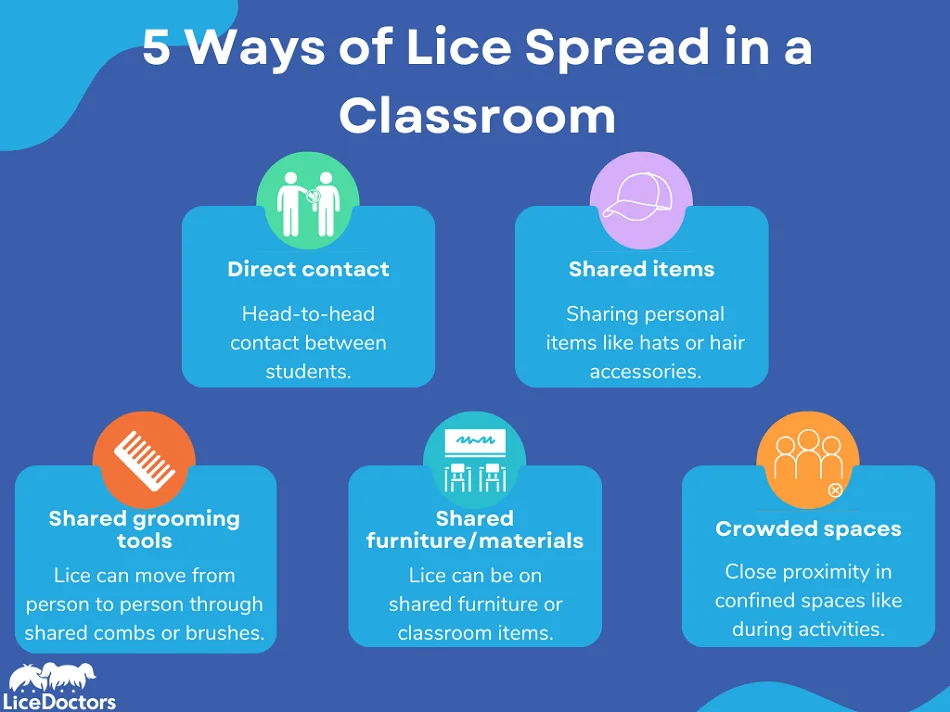The incidence of lice infestations varies among districts; in some schools, occasional cases are cropping up, while other schools are dealing with full-blown outbreaks. Parents often blame the school for the outbreak, one way or another.
One elementary school principal called us recently, overwhelmed because so many cases were discovered in so many classrooms that she begged us to come into the school over the weekend and do whatever was necessary to kill all the lice and stop the outbreak. But as we spoke with her, it became apparent that her fears about head lice living in the school were unfounded. Based on years of providing lice removal services, we will give you a guide for head lice in schools.
Head lice are tiny, wingless insects that are parasites found on the head of humans. They feed on the blood of the scalp and lay eggs on the strands of a child's hair or an adult's hair. The eggs that are laid are secured by a very strong glue and are difficult to remove. Live lice do not fly or jump and they don’t carry infectious diseases. They are unrelated to personal hygiene and are spread most commonly by way of direct head-to-head contact with another person with an active infestation which is defined as the presence of live lice.

During the school year, we see plenty of cases of head lice infestation. This is not due to a lack of cleanliness or a need to vacuum carpets; the real reason kids get these parasites so often during school time is because they are in close contact to other children who may have a head lice infestation. This is a typical school scenario:
You treat your child with a chemical lice shampoo and you assume she is lice-free so you send her back to school. Unfortunately, she still has some nits (lice eggs) that have blended into her hair. As the nits hatch, and the bugs mature, these crawling lice move from your child's head to another child as they are sitting in a circle or putting their heads together for an art project. This scenario gives the live head lice plenty of opportunity to move from one human head to another host.
Many schools now allow children with live bugs to remain until the end of the day so as to avoid stigma and missed class time. School policies have become more lenient based on recommendations from the medical community including both the American Academy of Pediatrics and the National Association of School Nurses stating that too many children were missing school due to this nuisance. With increasing numbers of schools eliminating the "no nit policy," more children may be passing lice on to their classmates. In addition, since the chemical treatments often fail to work, increasingly kids come to school post-treatment and within a few days they are contagious again and it is likely they will share with other kids.
1. Attending School with Head Lice
If your school policy is lenient, you may wonder if your child can go to school with lice: the answer is not straightforward. The risk of going to school with lice depends on the age of the student, as the physical closeness of their social interactions changes with maturity. The older the student, the less likely they are to pass on a case to school as they usually are not sitting head to head like some children. The best strategy is to get a lice professional to clear your child's hair but if you choose not to do this, have your child wear her hair up, coat the hair with a mousse, gel, or lice repellant spray, and advise her not hug anybody.
2. Notifying the School About Head Lice
Although not required, we urge parents to notify the school if their child has lice. Informing the school will definitely reduce your child's chances of getting lice again and help to alert faculty and other parents that there may be an outbreak. Overall, it can help to stop a lice outbreak before it gets bad.
3. Returning to School After Lice Treatment

After your child has been treated successfully, it is safe for them to return to school. Schools developed no-nit policies in an attempt to contain outbreaks, but treating lice can be challenging, and often parents treated over and over again just to have the school nurse send them home for having 1 or 2 nits left in the hair. That is why many schools dropped this policy.
If you are contemplating what to do after lice treatment, the answer to when you can return to school depends on the efficacy of the treatment; that time frame may vary, but if LiceDoctors treats your family members, they are safe to return to school the next day. There will be no live lice in the hair and even if a couple of nits remain, those are not contagious. Your aftercare plan will eradicate those.
A single child with an active infestation of head lice can spread adult lice to anyone they come into contact with. Therefore, ensuring that a child does not facilitate the spread of head lice in schools is a team effort on the part of the parents of the infested child as well as the school they attend. When both do their part, they can minimize the contagion.
Parents' Responsibilities
Treatment at home is very important. Parents should ensure that an infestation is completely eradicated, which includes removing all of the live head lice as well as the lice eggs. This is no simple task, but successful treatment of a child’s head is possible. Whether the child has short or long hair, check for sesame seed-sized bugs and nits, especially around the ears, and remove what you see. Comb through wet hair. If the child is treated properly, in addition to a thorough check on all family members and treatment where necessary, that child will not spread lice to their peers.
School Responsibilities

Schools are responsible for doing what they can to protect children and employees in the school district as much as possible from head lice. This includes setting appropriate policies for returning to school once a case has been detected. Prior to setting these policies, school nurses, as well as school district personnel, should educate themselves to avoid unnecessary absenteeism. For example, children with the presence of lice eggs only, need not be excluded from school as nits are not contagious. The American Academy of Pediatrics is in favor of removing no-nit policies from schools. Information such as this should be considered carefully to craft an effective policy for the district.
School Nurses Responsibilities
Health care providers employed by the school district, such as school nurses, have many responsibilities. One of which is detecting infestations in classrooms. Whether performing these checks themselves or bringing in a service to check classrooms, regular screenings can aid in the early detection of lice cases, which are easier to treat and will aid in the control of head lice in school communities. Because of this, the school nurse and/or school health aide should be knowledgeable about lice, their eggs, and how to identify them.

Preventing lice at school is key to keeping families free of lice and nits. Nobody with hair is immune to head lice, so here are some strategies to prevent lice at school:
- Parents should do regular head lice checks for the whole family even if no one has symptoms.
- When checking, make sure you have plenty of bright light and look closely at the hair shafts.
- Note that crawling lice move quickly so you are more likely to find nits than live lice.
- To do a more comprehensive check, apply oil to the hair and using a quality lice comb, start at the scalp and comb down the hair shaft.
- If you find a lice infection, we recommend that you soak combs, hair brushes, and hair accessories in hot water and soap or place them in the freezer over night.
- Medicated shampoos and other chemical lice treatments are often ineffective as the lice are resistant. Appropriate lice treatment products are a fine tooth comb and olive oil which will kill crawling lice and loosen many nits.
- Keep in mind, that while head lice are a nuisance, you do not have to worry about disease control; these sesame seed size bugs do not spread disease.
Don't let a head lice outbreak get out of control; call in the experts at LiceDoctors for a class head-check as soon as the trend becomes apparent. A team of experienced LiceDoctors professionals will be able to quickly identify the students who need to be treated, and you can confidently refer positive cases for our fully guaranteed in-home lice treatment service. For small groups, we can often even treat on-site! Give us a call at 800-224-2537 or visit our website to learn more about our school and camp checks and lice removal treatment service today.






